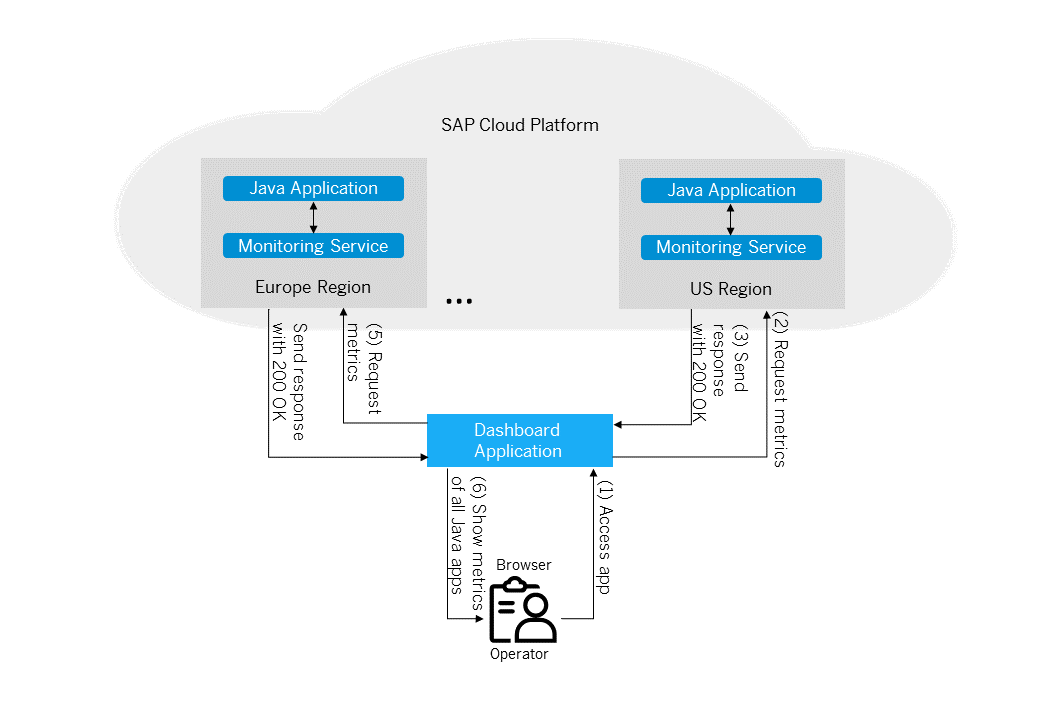
- SAP Community
- Products and Technology
- Technology
- Technology Blogs by SAP
- Use the Monitoring Service to Retrieve Metrics fro...
Technology Blogs by SAP
Learn how to extend and personalize SAP applications. Follow the SAP technology blog for insights into SAP BTP, ABAP, SAP Analytics Cloud, SAP HANA, and more.
Turn on suggestions
Auto-suggest helps you quickly narrow down your search results by suggesting possible matches as you type.
Showing results for
Advisor
Options
- Subscribe to RSS Feed
- Mark as New
- Mark as Read
- Bookmark
- Subscribe
- Printer Friendly Page
- Report Inappropriate Content
01-22-2016
4:08 PM
Note: This blog post is outdated. Please find the up-to-date version at Use the Monitoring Service to Retrieve Metrics from Different Java Applications in the Neo Environme....
Overview
You can use the monitoring service of SAP Cloud Platform to receive states and metrics of SAP Cloud Platform Java applications as well as of the applications’ processes. These Java applications can be in different SAP Cloud Platform subaccounts or even on different hosts (regions). For more information about the currently supported regions and their hosts, see Regions and Hosts Available for the Neo Environment.
The only requirement is that your user is a member of the subaccounts that the Java applications are located in. For more information about how to check subaccount memberships, see Add Members to Your Neo Subaccount.
To achieve this, you only need to develop a custom dashboard application that will display the metrics you need in the way you prefer. You can also use this application in your corporate network or in the SAP Cloud Platform network. Furthermore, you can choose your own UI technology for this dashboard application. For example, you can use SAPUI5 or SAP Fiori.
Process Flow
The communication between your dashboard application and the monitoring service works as follows:

- An operator accesses a dashboard application in the web browser.
- The dashboard application requests metrics of a Java application from the monitoring service with a REST API call. For more information about the REST call, see Monitoring API.
- The monitoring service sends back a JSON response with a status code 200 OK. The response contains the state and metrics of the requested application.
- The dashboard application parses the JSON response and places the metrics in a list.
- The dashboard application requests the metrics of other Java applications by repeating steps 1 to 5.
- The dashboard application’s UI uses the list with metrics to display those metrics in the browser.
Example
Donna Moore, as an operator of Company A, would like to use a central application to monitor the company’s Java applications and their processes. Company A is located in Europe, but it has a subsidiary in the United States (us1 region). Furthermore, the company uses the following Java applications:
- app1 - an application created for a1 subaccount and used in the Europe (Rot/Germany) region.
- app2 - an application created for a2 subaccount and used in the US East (Ashburn/VA) region.
For that purpose, Donna asks her developers to implement a dashboard application according to the instructions in Tutorial: Implementing a Dashboard Application
Conclusion
This blog describes a scenario in which you retrieve metrics of Java applications running on SAP Cloud Platform. However, your scenario might also include components from other platforms such as on-premise systems, other cloud systems, or public services. In that case, you can extend the dashboard application or your company tool to show the necessary metrics for such a scenario.
More Information
- SAP Managed Tags:
- SAP Business Technology Platform
Labels:
2 Comments
You must be a registered user to add a comment. If you've already registered, sign in. Otherwise, register and sign in.
Labels in this area
-
ABAP CDS Views - CDC (Change Data Capture)
2 -
AI
1 -
Analyze Workload Data
1 -
BTP
1 -
Business and IT Integration
2 -
Business application stu
1 -
Business Technology Platform
1 -
Business Trends
1,658 -
Business Trends
92 -
CAP
1 -
cf
1 -
Cloud Foundry
1 -
Confluent
1 -
Customer COE Basics and Fundamentals
1 -
Customer COE Latest and Greatest
3 -
Customer Data Browser app
1 -
Data Analysis Tool
1 -
data migration
1 -
data transfer
1 -
Datasphere
2 -
Event Information
1,400 -
Event Information
66 -
Expert
1 -
Expert Insights
177 -
Expert Insights
295 -
General
1 -
Google cloud
1 -
Google Next'24
1 -
Kafka
1 -
Life at SAP
780 -
Life at SAP
13 -
Migrate your Data App
1 -
MTA
1 -
Network Performance Analysis
1 -
NodeJS
1 -
PDF
1 -
POC
1 -
Product Updates
4,577 -
Product Updates
341 -
Replication Flow
1 -
RisewithSAP
1 -
SAP BTP
1 -
SAP BTP Cloud Foundry
1 -
SAP Cloud ALM
1 -
SAP Cloud Application Programming Model
1 -
SAP Datasphere
2 -
SAP S4HANA Cloud
1 -
SAP S4HANA Migration Cockpit
1 -
Technology Updates
6,873 -
Technology Updates
419 -
Workload Fluctuations
1
Related Content
- Consuming SAP with SAP Build Apps - Mobile Apps for iOS and Android in Technology Blogs by SAP
- Demystifying the Common Super Domain for SAP Mobile Start in Technology Blogs by SAP
- Deadline Monitoring for PO is not triggering E-mail. in Technology Q&A
- JMS driver based on jakarta.jms available for SAP Netweaver in Technology Q&A
- How do we monitor RFC user if its getting locked in Technology Q&A
Top kudoed authors
| User | Count |
|---|---|
| 36 | |
| 25 | |
| 16 | |
| 13 | |
| 7 | |
| 7 | |
| 6 | |
| 6 | |
| 6 | |
| 6 |